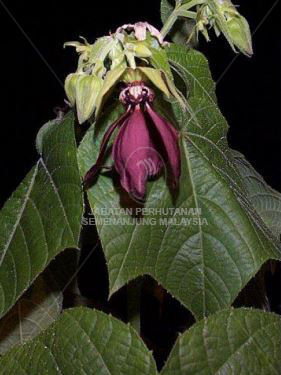Kapas Hantu
INTRODUCTION
Abroma augusta, or Devil's Cotton, is an evergreen tree native from Asia to Australia. This tree is common in many parts of India. It is also found in Pakistan and many Asian countries.
PLANT DESCRIPTION
They will reach 2.5 m in height with very little spread. The leaves will reach 20cm across and are 3-5 lobed with very distinct palmate veins. The leaves and stems are covered with soft bristly hairs that are very irritating to the touch. The bark yields a jute-like fiber. The flowers are 5 cm. in diameter. The sepals are lanceolate. The petals are 5 and purple to dark red, concave, and prolonged above into a large spoon shaped lamina. The seeds are many. The flowering season is July to August
PLANT HABIT
A half woody plant, with irritant hairs, found usually in thickets, not rare in the Peninsula Malaysia.
PLANT PARTS USED
Roots, leaves
USES IN TRADITIONAL MEDICINE
In Ayurveda the juice of fresh leaves is very useful in female diseases of uterus and menstruation. It regulates the menstrual flow and acts as an uterine tonic. Fresh and dried root-bark is used as uterine tonic and regulates menstrual flow. Fresh juice from root- bark is useful in congestive and neuralgic forms of dysmenorrhoea, amenorrhoea, urinary trouble and bronchitis. Leaf is used in diabetes, rheumatic pain and sinusitis. In Bali it is used as a plaster against scabies.







